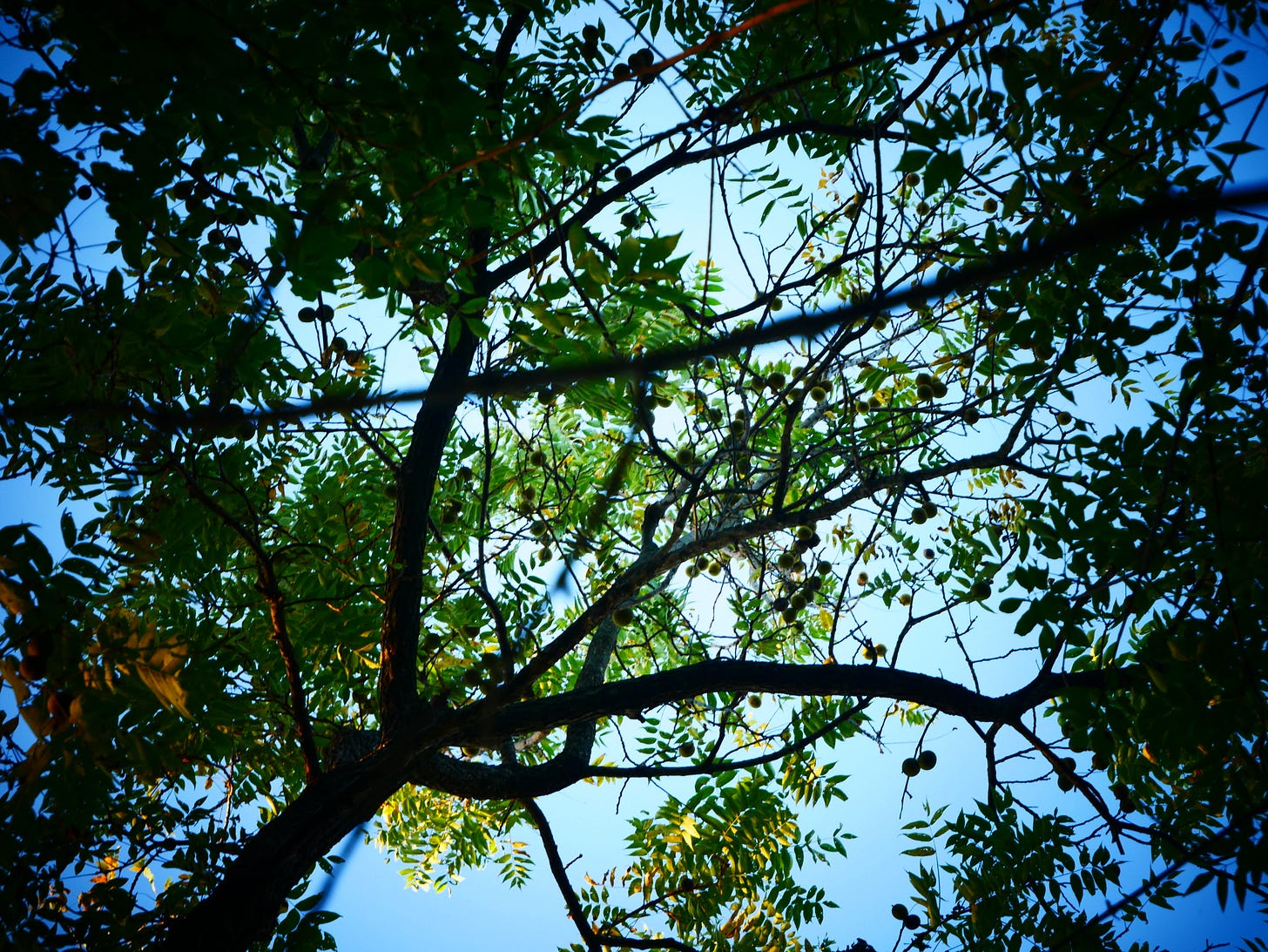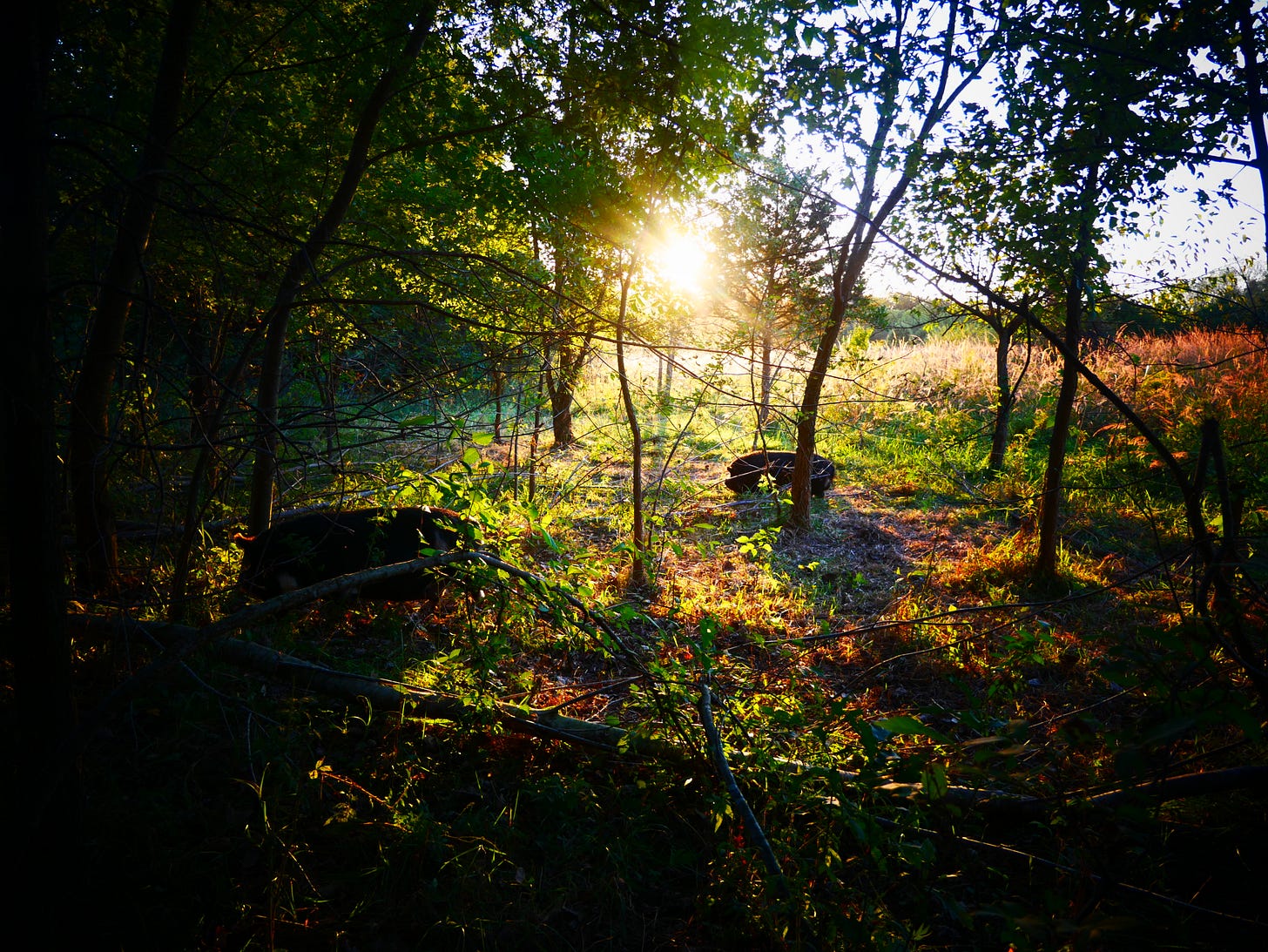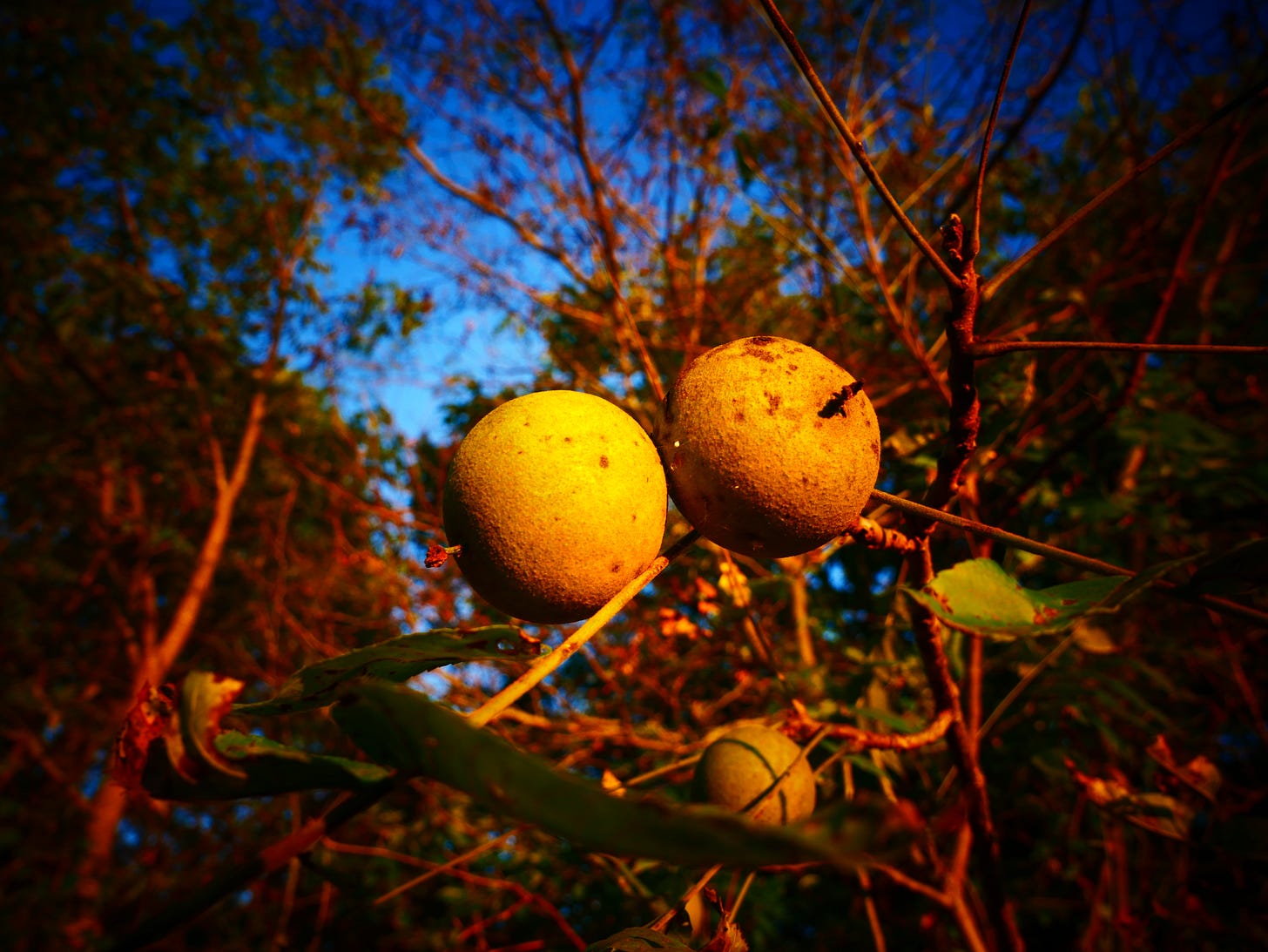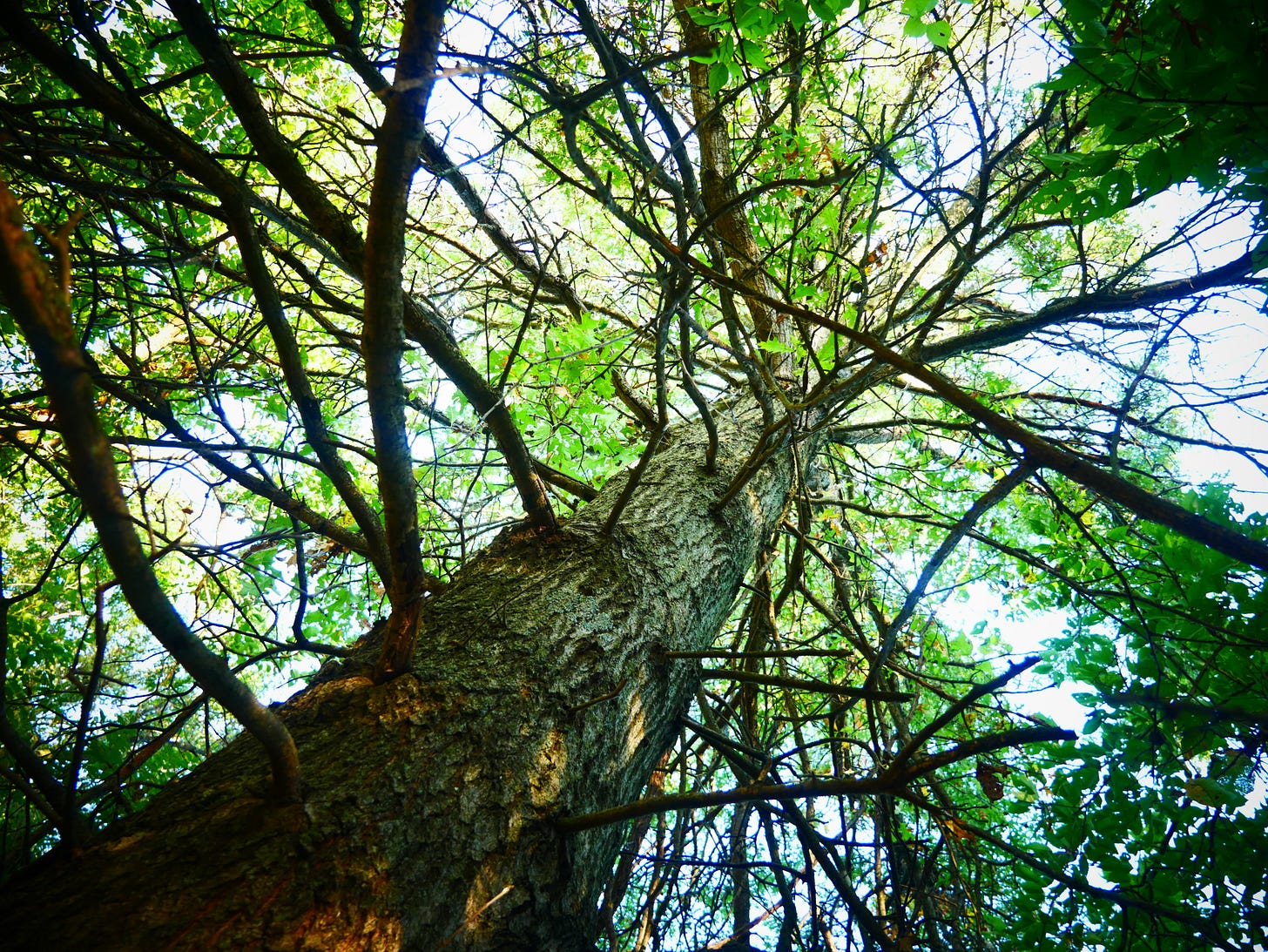Squirrel Type Behavior
...or the future we propagate
In the dew and spider-silk of daybreak I find myself tromping down the same narrowing path, each morning, lugging my slop bucket out along a cut in the prairie pasture, just downslope of the cows and among the wet, slapping stems of ripening warm season grass, heavy with gleaming seed. We’ve planted a contoured double-row of honey locusts and mulberries here, staggered on 16 foot centers –a toddling oasis of fodder and shade for cows or wildlife or even humans in an uncertain future. One day it will be a belt of dappled shade that rains digestible sugars, but for now, it is a meandering trail of plastic tubes zip-tied to fiberglass rods. Trudging through the wet grass, the mixture of oats and whey and culled squashes sloshing in their bucket, I come to the remnants of an old fence-row where we’ve herded the swine to clear through the tangled briars and gather acorns from the old pin-oaks planted by jays half a century ago.
The hogs line up at the paddock edge, grunting, their snouts inches from the hot-wire but otherwise as polite as hogs can be while anticipating slop. I plunge my plastic scoop into the mix and toss volleys of feed into their troughs. Windfall twigs crackle under their hoofs on the dry earth, and as the grunting and tramping give way to contented chewing and slurping, the faint clicks and clacks of acorns bouncing down branches ripples across the cool bottomlands, where squirrels leap in the weathered boughs of oaks.
I have worked to cut the wire out of these old fence-lines, now that it now hangs in the mud and becomes one with growth of cherry and oak and walnut– intentionally strung here in years past to control the movement of livestock, to subdivide this rolling prairie slope, to harness this soil and sunlight in pursuit of a century’s worth of saleable commodities. That was the intention, but with time, the squirrels came to chew their hedge fruit and acorns on fence-posts, spreading seed as they fattened. They buried their caches, forgot about them, and through neglect and happenstance, a thicket formed, and then a narrow corridor of woodland– a canopy-haven for the squirrels and jays that would expand from bottomland to ridge-top. A canopy now burdened with the weight of a major black-walnut mast.
I cannot help but engage in squirrel-type behavior, but without cheek-pouches, I must rely on buckets, boxes, and bags to gather my quarry. Out along the fence-row, as the acorns clatter, the heavy thud of pendulous walnut fruit punctuates the stilling song of migrating warblers, and following the sound of rolling nuts I find myself scratched up, covered in burs, but rich in walnuts an hour later. Like many wild nut-bearing trees, the Eastern Black Walnut is a masting crop– it produces heavy yields of nuts in some years and not others. Last year was a mast year for acorns. The year before, it was hickory, but this year belongs to black walnuts.
As a professional propagandist for trees, I am supposed to tell you that black walnuts have a rich unique flavor– a mixture of buttery, fruity, herbal, even cheddary notes. I’m probably not supposed to mention that they are an acquired taste, or that they specifically have a hint of permanent marker and strong scotch whiskey. Nobody enjoys them when they go rancid, but fresh out the shell they are a taste which I have definitely acquired myself. Perhaps the best way to acquire the taste yourself is to, like a squirrel, put in the hours of labor required to freely consume them, and/or require them for your survival.
I gather the heavy crop in bags and buckets and boxes, but never in anything so pretentious as a basket. I leave quite a few for the squirrel kin. Then, the tough, sometimes green and fleshy, sometimes black and maggoty hulls must be removed. To do this, I soak the fruits awhile to ferment and soften their flesh, then fill a bucket quarter-full with walnuts and water, and using a sturdy paint-mixing drill bit in a powerful half-inch corded drill, I do my best to beat the living shit out of them for a minute or two, sloshing the blackened mixture of liquid all over myself (I now have dedicated clothes). Some of the hulls will be loosened, some of the nuts will emerge, but others will either need to be further pulled apart by hand or left to soak longer. This step seems to be time/labor bottleneck in my technique, so I am fixing up an antique hand-crank corn-sheller to streamline the de-hulling process.
Observation and anecdote seem to suggest that the longer a black walnut remains in the hull, the sharper and stronger the flavor is, so I try to do this step as soon as I can. The hulls and liquid are a strong dye, and with or without sturdy rubber gloves, my hands just look filthy all the time. While it might seem like a reasonable excuse while at the bank or parent-teacher conference, I often forget that the idea of harvesting and processing hundreds of black walnuts is not common among humans these days– in polite society (or at least Northeast Missouri) it is squirrel type behavior.
After some repeated rinsing, the walnuts (only the ones that sink instead of float), in shell, are allowed to cure in a cool, dark location with good airflow. In a rack out in the shade of trees was working for me for about an hour until the squirrels showed up and began taking the nuts I’d so diligently processed for them, so I had to come up with an enclosed steel mesh try. It takes a few weeks for the shells to grow a bit more brittle and the kernels within to firm up and grow crispy.
In terms of cracking, the shells of black walnut are supremely hard, and the kernel is deeply interlocked with them. A heavy-duty nutcracker, along with some sturdy hand shears are a necessity for more than a few. And while I do not receive requests for endorsements in the almanac, paid or otherwise, I have to personally recommend getting “Grandpa’s Good Getter”, manufactured right here in MIssouri, not that they would necessarily appreciate the association with me. Show me a better nutcracker, with a better name! (The MasterCracker is a close second though.) Out of the shell, walnuts can go rancid quickly, so my plan is to crack a few at a time throughout the winter, and hang my stash up in mesh bags on nails around the beams and rafters of our home for a little farmhouse flair.
I have never noticed a crop of black walnuts of this scale before, and I have found myself easily distracted in all avenues of my life, knowing they’re out there, dropping every minute, piling over the duff of the forest floor. I’ve grown a bit obsessive with it– squirrel type behavior. Or is it something deeper than that?
Like squirrels, humans have succeeded over the evolutionary timeline by gathering and stashing nutritious food. The somewhat recent advent of agriculture and civilization is both a progression of this advantageous behavior, and something of a digression as well. Agriculture and civilization allows us to organize our survival with some intention, and civilization allows for the division of labor to make that survival efficient –at the cost of resource extraction and class hierarchy. Yet, personally, I’ve never been a big forager– I like my wild treats, but I’m not interested in starvation, so I plant crops and tend livestock in an organized manner for more of a guaranteed yield. But there is some innately human feeling that comes with the thrill of greedily filling containers with wild food, especially when there’s more than enough. I engage my surroundings with my feet and hands and eyes, I get scratched up and bleed, I scurry, I get lost in the woods, and when I see my hoard of nuts lined up for processing, I feel some deep sense of security, as the days tilt towards darkness and the world of leaf and stem dries down to dormancy.
Of course, in the process of harvesting and hoarding, in both the squirrel world and my own, we drop a few seeds unintentionally. This may be the evolutionary advantage of masting crops– most years they sustain a small population of seed predators, and then once in a while, they overwhelm it. All the goodies cannot get got. And so we, the squirrels and the humans, miss a few here or there, spill or drop a few in our travels, or just forget about our caches, and over time the range of these useful trees shifts with our movements. This is also particularly true with blue jays and acorns– it may take centuries for a species of oak to emerge on the other side of a mountain range, but given the proper conditions and the help of blue jays, they often will. With or without intention, squirrels and blue jays and humans all propagate our own long-term survival by this simple act of gathering food in the face of seasonal uncertainty.
But as the darkness of this autumn creeps in, I begin to wonder how we propagate a viable future in the face of real threats to life on Earth.
The squirrels and blue jays and hogs and I are grateful for the relic fence-line, now littered with food. It feeds quite a few of us, but it cannot possibly scale to meet the demand of a world in need of so much care– a world descending into mass extinction, mass incarceration, full-throated fascism and the highest level of class inequality ever, to name a few of the higher priorities. In other words we must plant our seeds with some intention, and act as though survival is no guarantee.
Typing near the attic window with my hands stained black with walnut hulls, I watch a squirrel leap bough to bough on the generous mother hedge tree that embraces this old fence-row. Obsessively climbing up and along the arching boughs, the squirrel has some pin-oak acorn stuffed in its mouth. It takes trip after trip up to a crotch in the branches, where it deposits the growing cache of seed. A gang of blue jays has now arrived, and is harassing the squirrel– this is what I do for entertainment anymore, but it does lead me to consider the nature of cooperation. Blue jays prefer acorns to black walnuts, as a blue jay would find them cumbersome to hoard and difficult to crack. But the squirrel is taking the limited supply of them, and I have been keeping this particular squirrel (I know a lot of them) from eating my own hoard of black walnuts. I suppose one could describe this all as human-type behavior.
The Russian anarchist (anarcho-communist? Who cares anymore…) and geographer Pyotr Kropotkin noted that “Mutual aid is as much a law of animal life as mutual struggle, but that, as a factor of evolution, it most probably has a far greater importance, inasmuch as it favours the development of such habits and characters as insure the maintenance and further development of the species”, and if I think that sounds about right to me. In other words, fencerow squirrels like us might be scrappy and lucky enough to live through this winter, but for the long-term survival and advancement of our progeny, we need some organization… maybe even some intentionality. We can’t just eat seeds. We need to plant them too.
The long-held farming ideal is that our organization of crops, soil, and energy resources must be static, unchanging, and reliable. These conditions might promote a fairly predictable (and exploitable) market in the short-term, but do little to support long-term survival and advancement. And they do not reflect the reality of a functional ecosystem. Nothing is permanent here on the prairie, or in the woods– which is a part of why terms like permaculture or permanent agriculture are a bit of a misnomer. Out here on the tallgrass prairie, changes in our burning and grazing regimen –not to mention climate and weather– favor or disadvantage different species compositions: and no amount of attempted human control can keep it the same forever. The continued survival of our culture relies more heavily on change than stasis– the shifting, dying, sprouting chaos of soil, sun and seed.
Here in the US, the bottom seems fairly certain to drop out on what we once assumed was permanent– our economic dominance, our quality of life, and our basic democratic framework. And without being alarmist, it probably will all crumble, eventually if not imminently. If you find it concerning, I recommend going out to pick up a few walnuts– if it doesn’t teach you how to be more like a squirrel, it might at least teach you how to be more human.









Lovely piece! It's a mast year here in Virginia, as well, and I have been putting all my nature school students to work gathering walnuts. Thanks for the tip about paint-mixing drill bit.
I was just thinking about how people hear the perma part and immediately think of making the agriculture part permanent instead of the culture part. Not that an ecological culture would be static but it would ideally keep humans around longer than our present arrangements seem likely too.
Foraging is an interesting case in regards to provisioning calories. In terms of return given that harvesting and processing are the only steps it's quite good, but in terms of area you're liable to quickly run into issues with our current ideas about property rights.